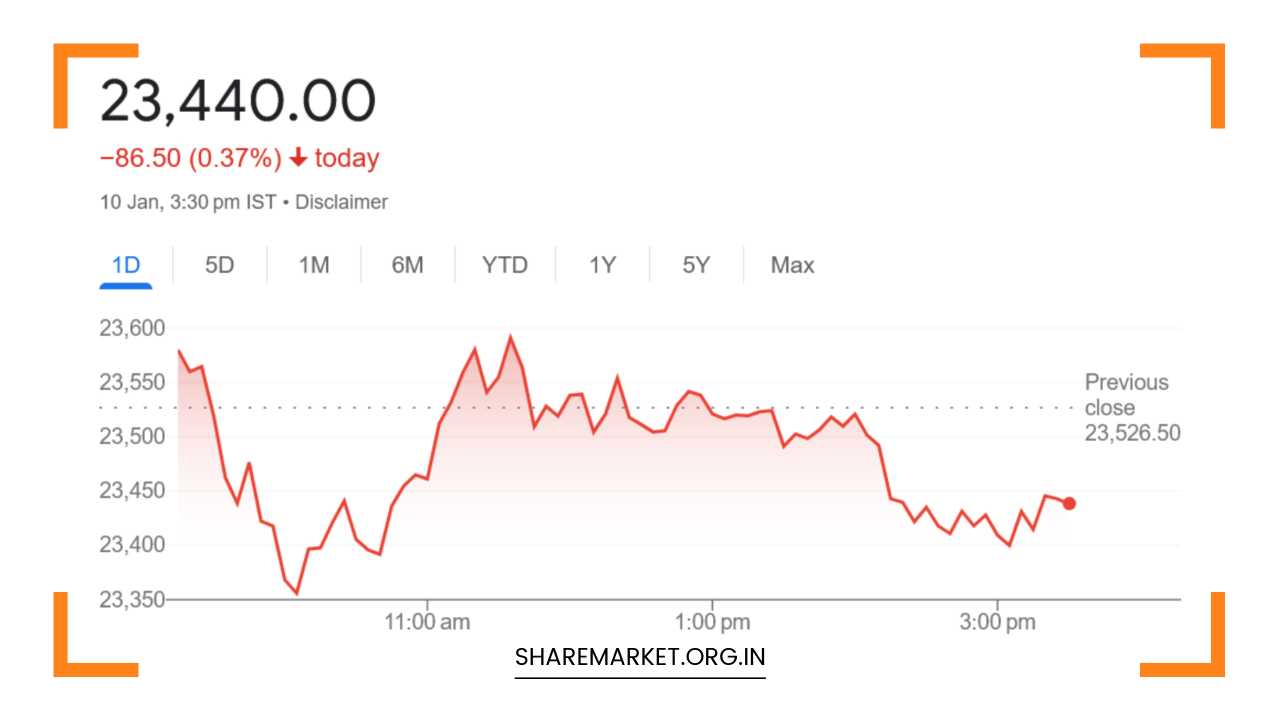Sensex Down 241 Points, Nifty at 23,440; Nifty Prediction for Monday

Nifty Prediction for Monday
Market Update: January 10 – A Bearish Close, What’s Ahead for January 13?
On January 10, Indian equity markets closed in the red, with the broader indices facing selling pressure across most sectors.
The Nifty Index, which had seen some level of optimism earlier, slid below the 23,450 mark, signaling potential bearishness in the near term.
The Sensex ended the day at 77,378.91, down by 241.30 points or 0.31%, while the Nifty closed at 23,431.50, reflecting a loss of 95 points or 0.40%.
Despite some individual stock gains, the overall market breadth was negative, with 777 stocks advancing, 3,048 declining, and 87 remaining unchanged.
Key Sectoral Performance
The day witnessed a sharp contrast in sectoral performances. The IT sector, which has been a strong performer over the past few quarters, provided some support to the market, with heavyweights like TCS, Tech Mahindra, Wipro, Infosys, and HCL Technologies being among the top gainers.
The positive performance of TCS was particularly noteworthy, as it helped keep the broader market from a sharper decline. TCS’s earnings for the quarter exceeded expectations, and the company’s management’s optimistic commentary on its deal pipeline and expectations of discretionary spending provided a boost to investor sentiment toward the IT sector.
However, the broader market faced challenges. The BSE Midcap index fell by 1.2%, while the Smallcap index saw a more substantial decline of 2.4%.
Most other sectoral indices closed in the red, with notable declines seen in Power, PSU, Realty, Healthcare, and PSU Banks, each losing around 2%.
The widespread weakness across these sectors reflects the cautious sentiment prevailing in the market as investors continue to grapple with macroeconomic uncertainties, particularly regarding interest rates and inflationary pressures.
Expert Insights: Market Sentiment and Volatility Ahead
While the market showed some signs of resilience in the IT sector, the broader sentiment remains cautious. Aishwarya Dadhich, Founder and CIO of Fident Asset Management, commented that the market is expected to remain volatile for the next three to four weeks.
He highlighted key events such as the upcoming US payroll data and the Union Budget, which could lead to heightened market fluctuations.
These events, particularly the Union Budget, could have significant implications for sector-specific policies and government spending, influencing investor sentiment.
Dadhich also pointed out that the results season would play a critical role in determining the market’s direction in the short term.
If corporate earnings disappoint, especially in the mid and small-cap segments, the market could see increased selling pressure.
Conversely, strong earnings reports, particularly from companies that are undervalued or trading at attractive valuations, could provide much-needed momentum and restore investor confidence.
Ajit Mishra of Religare Broking echoed this sentiment, noting that the overall market trend appears to be tilted toward bearishness in the short term.
He emphasized that traders should remain cautious and use any temporary bounces as opportunities for shorting the index.
With the market in a consolidation phase, traders need to focus on stock-specific movements rather than making broad bets on the index.
Mishra also advised that long positions should be carefully considered in relatively strong sectors, while weaker-performing sectors might offer more attractive opportunities for short trades.
Sectoral and Stock-Specific Movements to Watch
One of the key factors influencing the market’s performance in the coming weeks will be the continued earnings results, which will provide crucial insights into how companies are navigating current economic conditions.
The IT sector is likely to remain in focus, as TCS and other top performers continue to benefit from strong deal pipelines and improved global demand for technology services.
The performance of mid and small-cap stocks will also be a crucial factor to watch. As Dadhich noted, if these segments show disappointing results, the market could face additional downward pressure, as investors may seek safer, more liquid assets in the wake of underwhelming earnings reports.
Another important development to watch is the performance of the banking sector. Financial stocks have been showing some resilience in recent months, but their performance will heavily depend on the outlook for interest rates and inflation.
If inflation remains elevated and the Reserve Bank of India (RBI) adopts a more hawkish stance, the banking sector could face headwinds due to potential higher borrowing costs.
On the other hand, if inflation begins to ease and interest rates stabilize, banks could see improved margins, which could drive investor interest.
Technical Outlook: Key Levels for Nifty and Bank Nifty
For traders focused on technical levels, Hardik Matalia, a derivative analyst at Choice Broking, provided important support and resistance levels for both the Nifty and Bank Nifty indices.
According to Matalia, the Nifty index has immediate support at 23,300, with further support at 23,200. On the upside, the first resistance is seen at 23,600, followed by stronger resistance at 23,700 and 23,800.
If the Nifty breaks below 23,200, it could open the door for further declines toward the 23,000 mark.
In the case of the Bank Nifty, Matalia suggested that the index could find support at 48,900 and 48,500, with immediate resistance at 49,800.
Should the Bank Nifty rise further, it may face significant resistance near 50,000 and 50,300. Traders should closely monitor these levels to gauge the direction of the market and make more informed decisions.
Market Prediction for January 13 and Beyond
Looking ahead to January 13, market participants should brace for continued volatility. With earnings season in full swing and important economic events on the horizon, there could be significant market movements, particularly in reaction to individual earnings reports and key macroeconomic data.
Given the prevailing bearish trend and cautious sentiment, it’s likely that the market will remain in a consolidation phase unless there is a catalyst that drives investor confidence.
For short-term traders, it would be prudent to adopt a tactical approach, using any rallies to establish short positions and focusing on individual stock movements rather than betting on broad market trends.
Long-term investors, on the other hand, should pay close attention to sectoral trends and earnings reports, as these could provide clues about the broader market’s potential direction in the coming months.
Overall, while the IT sector remains a bright spot in an otherwise subdued market, the broader economic conditions and upcoming events will play a pivotal role in shaping market sentiment over the next few weeks.
Maintaining flexibility and closely monitoring key technical and fundamental developments will be crucial for investors navigating this uncertain landscape.

















